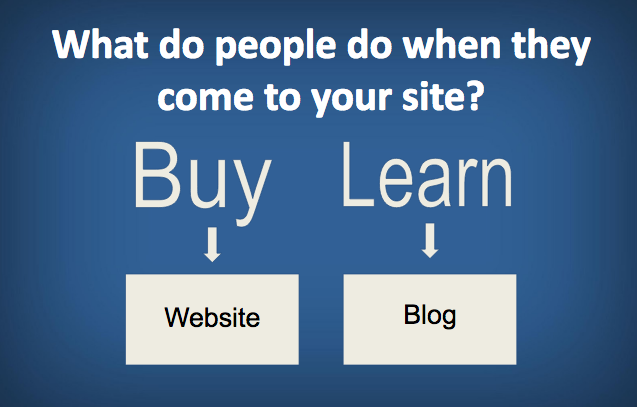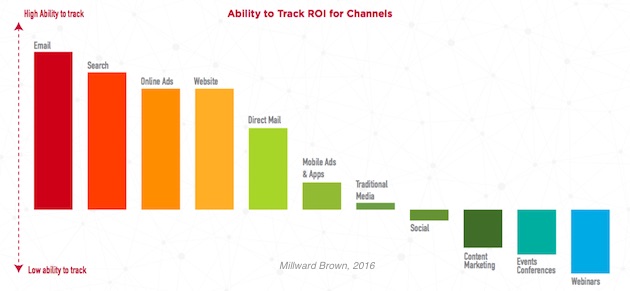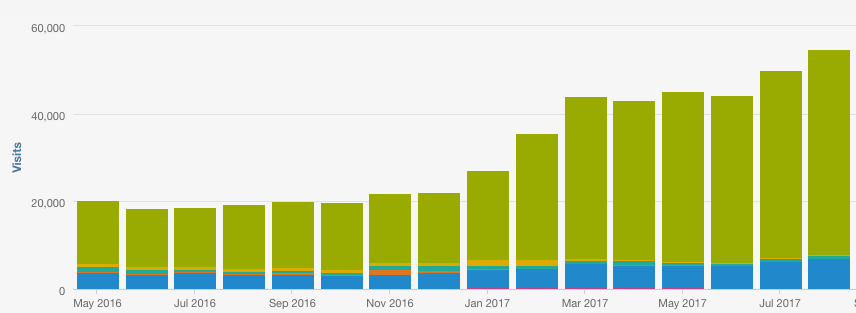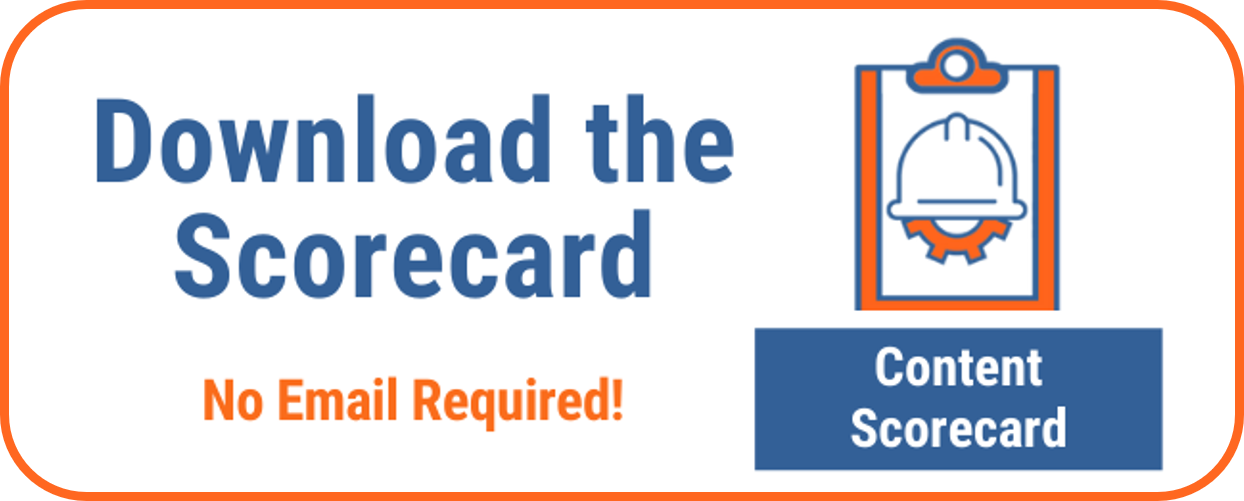Explaining how content marketing works, including the impact it can have on your bottom line, is the key to get funding for this proven marketing tool. Here’s how to do it in language your boss will understand, especially the part about it being VERY good for your business.
When you’re in marketing, you really don’t get too much respect.
Even though the greatest companies in the world are built on exceptional marketing, companies tend to view small marketing departments more as an expense than an asset. You’re there to print brochures and make sure the logo looks great.
Beyond that, your boss might not expect much. But with content marketing, you have a unique chance to make a dramatic impact with your marketing — and transform your role from marketing expense to profit center.
But it’s all in how you sell — er, explain how content marketing works.
What is content marketing?
Let’s start out with the essential definition of content marketing. Content marketing is the use of content to inform current and potential customers and attract them to your website.
“Content” is an article, a story, a product definition, a testimonial, a picture, a quote, a chart, a statistic, a video, a sales pitch, a cartoon. It’s communication, folks. And it’s communicating messages about your company, products and services.
Big deal. Where the heck does a definition get you? It won’t get you anywhere with a boss who doesn’t care what the latest marketing jargon is, and has some very pointed questions. As in…
Why use content marketing?
That’s the question. And my one word answer is very simple:
Search.
I was talking to an insurance salesperson the other day, who told me her biggest challenge in selling her product is that people only buy it when there is a problem with their coverage.
So what do people do when they have a problem? They search for an answer.
In the past, they might have picked up the phone and called a neighbor or a trusted business friend. Now they Google. They look on social media. They go to their phone, their desktop, their iPad, and they search the web.
Wait, does search = Search Engine Optimization? Is that the goal?
Sure, SEO is a big part of it. When I say search, however, I mean more than just keywords. When people who are just scrolling through Facebook, LinkedIn or Twitter feeds are searching, they’re searching for something to read, entertain or wow them.
At its core, you use content marketing so that when people search (whatever the reason), you are there to inform, to share expertise, and ultimately, to sell.
Your boss should be nodding at this point in the conversation. Not too much jargon from you, and this is common sense, right? Now it’s time to move the boss to the next big question.
How does content marketing work?
Content marketing has a ton of moving parts. It can encompass your website, social media, other people’s websites, a whole host of technology products — but how in the heck does the ding-dang thing work?
Here’s how to explain it in a nutshell. (And any boss loves a nutshell.)
Think of your website having two parts: the website and the blog. When people come to your website, they come to buy. When they come to your blog, they come to learn. (Technically, the blog is part of the website, but don’t get into that now. You’ll only confuse the boss.)
Creating content for people who buy and people who want to learn
Let’s say your company is selling scooters.
On your website, you will have keywords and keyphrases for people who want to buy a scooter. A headline for a web page might read:
Scooters for Sale:
Choose from the widest selection of two-wheeled
scooters in the world.
Your blog is different: It should have keywords and keyphrases for people searching for information about scooters. A headline for the blog post might read:
10 ways to ensure your child is riding a scooter safely
So you optimize those pages based on the different types of searches people are making. Now here comes the a-ha moment.
The key to effective content marketing: Generate links to your “information” pages so that your “buy” pages will rank
That’s a very long headline, but it’s really the basis for content marketing. You want to create exceptional informational content that people will link to. Why?
Because one of the main factors behind how high Google will rank your pages is how many people link to it. People aren’t going to link to a “Buy” page. But they will link to an “information” page.
Take our Scooter example. Let’s say you share the article “10 ways to ensure your child is riding a scooter safely,” and it has a lot of great stats and information in it. Soon other bloggers and safety sites start to refer to it in their own posts. Parenting websites put a link to it on their resource page. New reporters write an article and link to your findings.
All those inbound links tip off Google that you are an authoritative site, and they will rank your keyphrase “riding a scooter safely” very high.
As those inbound links pile up, it begins to affect your ranking on the “buy” pages, because that’s how Google rankings work. Suddenly, your page for “Scooters for Sale” will start to shoot up in the ranks.
The result? When people search for information, they find you AND they learn from you. When customers search to buy, they find you AND they buy from you. All because your blog — filled with non-sales content — boosted the page ranking for your website’s sales pages.
It’s all about search, remember? It’s about moving your ranking above your competitors’ ranking. And now you’re offering your boss a mechanism that will make people find your company’s name first.
How to do content marketing: Making it all come together
At this point, your boss should be hooked, primarily because you’ve used the word “buy” repeatedly. But they may start doing a bit of head scratching, and ask questions like:
Well, how does Facebook figure into this?
Who the heck is going to create content?
How do we track this ding-dang thing?
You should be doing a little happy dance, because your boss is actually talking to you about marketing. They actually are seeing a system they can wrap their arms around. You’ve explained how digital marketing works in a (you guessed it) nutshell.
So let me just touch on how the rest of the elements come together. Again, there’s more complexity to all of these moving parts, but that’s for you to deal with once you get your boss committed to the big picture. Here we go:
Social media: Use instead of just reposting other people’s content.
You can also use social media to find influencers who can contribute to your post and make your content even better. Often they’ll link to it from their own social networks and blogs because it’s so dang important (and because it improves traffic to their own sites).
Email marketing: Creating great content is an excellent way to build your email list. If people like your content, they might subscribe to your blog. (Like ours — see that little sign-up box on the sidebar?)
As you build your list, the people who receive the email can act as distribution points for your content (as they share your posts) and potential prospects. Email marketing boasts the highest ROI among content marketing channels (as noted in this chart from Ayaz Nanji in this MarketingProfs post), so building your own list is a must.
Driving sales: So if you rank high for “buying” pages, where does that leave your sales department? This is where sales and marketing can really come together.
Not only can your sales team help you create the right messaging on your buy pages, they can become conduits for your content, establishing themselves as experts in the process. Here’s our post on the topic.
YouTube, Podcasts: I break these out from social media only because they are ways you can repurpose and repackage your content. Your boss may ask why you aren’t doing YouTube or podcasts — and you can do those instead of a traditional blog — as long as they’re part of your overarching plan to rank for keywords.
Any type of content will work, it just needs to rank for you. Below you can see how we repurposed content into a video, and then inserted it into a blog post.
Paid media (Facebook ads, LinkedIn ads, pay-per-click ads): We are big fans of any types of paid digital media, and it can definitely be part of the mix. The only problem is that your ads will only bring in as much audience as your budget will allow.
When you start ranking for keywords, your traffic can increase exponentially. Note the keyword ranking for one of our clients. They maintained the same budget, but experienced a dramatic increase in traffic.
We recommend content marketing as your baseline, then experiment with paid advertising on top of it. Test, test and test some more.
SEO: Bosses who are astute enough to mention SEO will be happy to know that much of what you’re talking about is SEO. Take a look at most of the SEO companies that are dropping the “SEO” and becoming “content marketers.” That’s what it’s all about.
How to do content marketing: The big question
Ok, so you’ve explained content marketing to your boss. By now, he/she is thinking that this content marketing just might be the most sensible thing you’ve come up with yet (even though you’ve probably had a gazillion ideas that just went over his/her head).
So now the big question coming your way — how do you DO content marketing?
That’s definitely a topic for a much larger post, but here are some of the roles/jobs you’ll need to consider:
- Content strategy
- Content creation
- Content publishing and distribution
- Social media monitoring and publishing
- Analytics
- Keyword research
- Conversion optimization (if you’re smart)
You’ll need to determine how much of this you’ll do yourself, how much you’ll allocate in-house, and how much you’ll outsource.
But the beauty of it is that once you get rolling and start seeing results, the boss will not only understand what you’re doing, but how valuable you are to the organization. Cha-ching for the company, and cha-ching for you!
Find out how your content and conversion ranks with our interactive version of the Content Scorecard you can fill in yourself – no email required for download.













